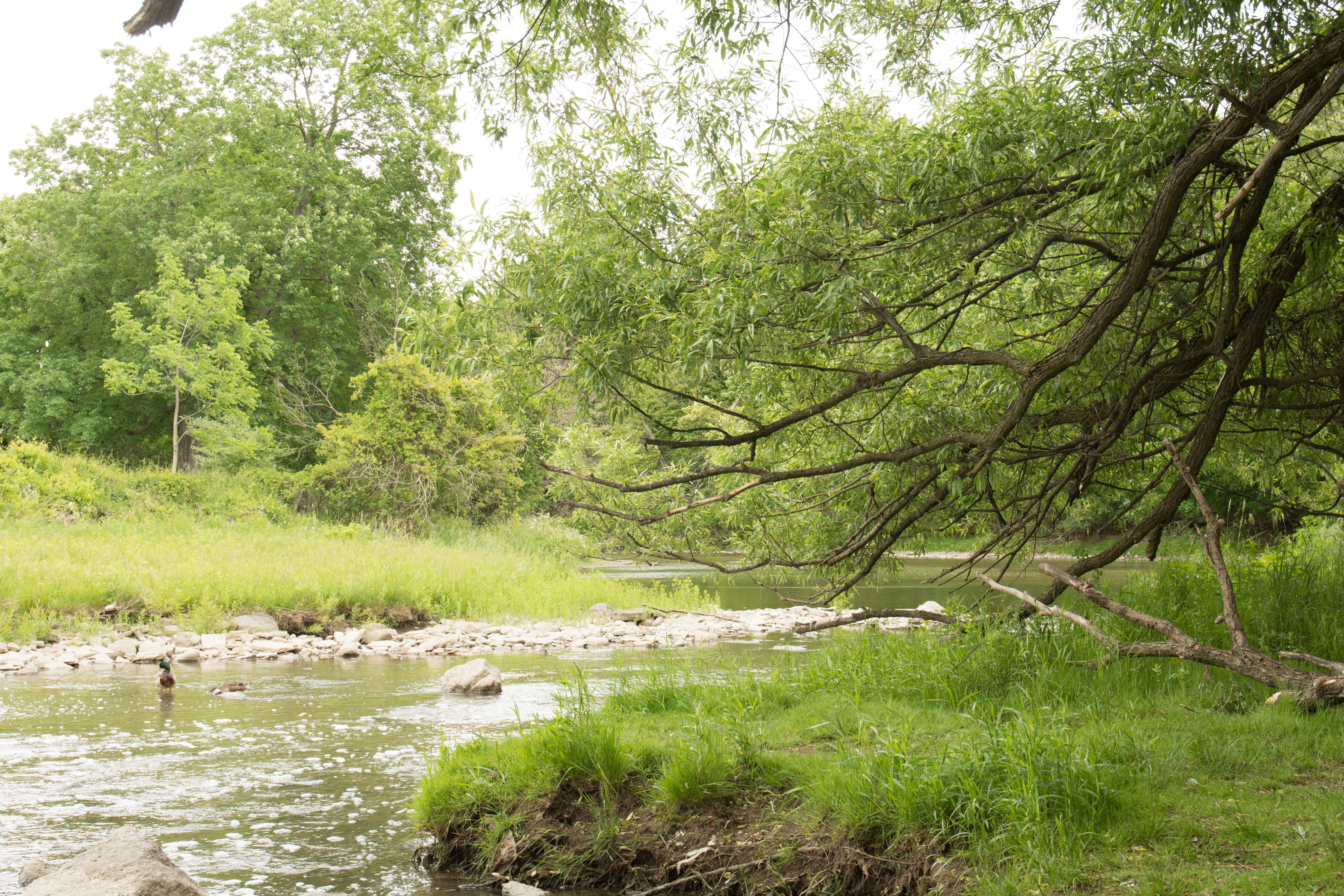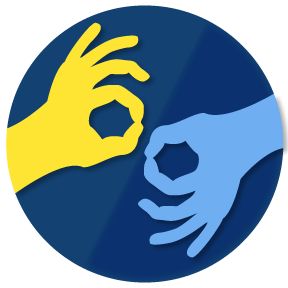
Humber College Land Acknowledgement
Image source: Humber Archives
Humber College is located within the traditional and treaty lands of the Mississaugas of the New Credit. Known as Adoobiigok, the "Place of the Alders" in Michi Saagiig language, the region is uniquely situated along Humber River watershed, which historically provided an integral connection for Anishinaabe, Haudenosaunee, and Wendat peoples between the Ontario Lakeshore and the Lake Simcoe/Georgian Bay regions. Now home to people of numerous nations, Adoobiigok continues to provide a vital source of interconnection for all.
A land acknowledgement is a statement that indicates that the speaker is committed to decolonizing their thinking and is in support of Indigenous sovereignty affirming movements. It is an opportunity for education and engagement with Indigenous epistemologies and ontologies as well as an opportunity to disrupt euro-western cognitive imperialism. It is also an opportunity for people to understand how they can be in relationship with the land and all its human and non-human inhabitants.
The land acknowledgement identifies the Nations who have had and who are currently in a traditional territory relationship with the land as well as the histories of the land and the people who live there. This signifies a dialogue that includes recognition of Indigenous nation sovereignty and upholds Indigenous territorial laws and observances. The statement accepts or confesses to the histories, events and circumstances that led us all to be in this place in this time; a way of noting a journey that includes past, present and future moments. This is Indigenous knowing that defies euro-western colonial thinking. This is often where treaties are identified but it is also important to identify how treaties have been and continue to be broken.
The speaker of a land acknowledgment could also identify themselves as an invited guest, settler, visitor, or kin. The intention here is to indicate the nature of the relationship to begin to identify the responsibilities that relate to that particular role. For example, the responsibilities of settler would have some different aspects than that of visitor. In this way the land acknowledgement invites the speaker and the listeners to consider themselves in relation to the place and community where they are located. In other words they can see themselves as people who are affected by the treaties in place in the territory they may live or work, or if there is no recognizable treaty then to be subject to the laws and observances of both nations: Canadian and Indigenous. At the same time that land acknowledgements should be truthful about the horrors of colonialism, they are also an opportunity for hopeful thinking about the way forward.
In recent years many colonial institutions have taken to reading a short land acknowledgement statement at the beginning of meetings, conferences, and other events. In general, these statements acknowledge the Indigenous nations in the territory where the meeting is being held. There is a danger that these statements have become perfunctory, and therefore meaningless. A land acknowledgement should be taken as an opportunity to deeply reflect on our individual and personal relations to past, present and future moments. This again is in keeping with Indigenous ways of being and knowing. It is a call to action and a signifier of change, the statement itself should not be the only indication of a land acknowledgement. The intentions of the statement should be evident in the proceedings, in the institution and in the people making the statement, otherwise it is a meaningless performance that perpetuates the very oppression it seeks to oppose.
We are beginning the day with greetings and acknowledgement of the land that we are working/meeting in and the original peoples of this territory. We do this because we believe that we all have work to do in building a better relationship between the Indigenous peoples of this land and those of us who have come to live and work here. A land acknowledgement is a chance to educate ourselves about what has happened and is continuing to happen in this land we now call home.
We know that for over 15,000 years people have lived in this area that we now call Toronto but was also called Tkaronto by the Mohawk Nation. This area is now the traditional territory of the Mississauga of the Credit but other Indigenous Nations including the Anishinaabe, Wendat and Haudenosaunee have called this area home as well.
One of the ways we can build relationship is to understand that Indigenous peoples who lived in what is now called Canada never willingly agreed to give up their Nation-hoods, cultures, languages or lands. Indigenous peoples have always dealt with Canada and Britain in a Nation-to-Nation way, government to government, creating contracts called treaties, that described the way the Nations would work with each other. This is called sovereignty. Indigenous Nations have always fought hard for the government of Canada to recognize them as sovereign Nations.
One of the treaties created in this area is the Williams Treaties (1923) between the Mississauga of the Credit First Nation and the government of Canada. Another treaty of this territory is called the Dish with One Spoon Treaty. This treaty explains the ways each Nation who lives here will share this territory and be peaceful with each other - not using knives - but using a spoon to equally share in what the earth, provides to us. These treaties are important to discuss because they are still in effect today but unfortunately, they have not been properly upheld by our Government.
These treaties affect all of us who live here now. In this way, we are all treaty people and can think about how we all want to be able to take care of this territory as well as share in the gifts the earth has to offer. But even more than that, we want to think about supporting Indigenous Nations to gain back what they have had taken from them. This includes land agreements, but also knowledge, language and traditions.
As guests, visitors and people who have settled in this territory, it is important for us to recognize that Canada continues to treat Indigenous peoples unfairly and un-justly while they and all of us live on land that was taken through violence, threat, tricks and lies. The government of Canada and all of us have a responsibility to not stand by and watch as Indigenous people continue to be harmed in many ways, including:
- children are still taken away from their families,
- many reserves do not have clean drinking water, adequate housing or schools, and lack health care,
- Indigenous women are missing and murdered,
- Indigenous people are put in jail in higher numbers than anyone else
We can understand this as colonial violence, violence that is committed by a Nation that wants to take another Nation's land and remove or conquer its peoples. Colonial violence works hand in hand with racism, ableism, sexism, transphobia and homophobia and other kinds of oppression. So in this way, many of us are affected, even if we are not Indigenous.
As people who are interested in fairness and justice for Indigenous peoples and for our communities, this land acknowledgement is about education, but it is also a chance to think about action. We live in a place with a treaty that says we will treat each other equally, what can we do to uphold that treaty?
We are beginning the day with what is known as a "land acknowledgement". A land acknowledgement is a statement recognizing the rights of the original peoples of Turtle Island. A true land acknowledgement should not just be about naming the people who lived in this area - it is about knowing the story of the land, knowing your place and purpose on the land, and what is expected of you as someone who lives here.
For over 15,000 years, Tkaronto has been a place where people have lived. Tkaronto is the original name for Toronto in the Mohawk language. This is the land of the Anishnaabe, Wendat nations and the Haudenosaunee confederacy.
Before we start, we want to acknowledge the traditional land of the Haudenosaunee, Anishinabe, Mississauga of the Credit First Nation. I am a descendent of invaders who were not invited to this land and who stole the land from the first peoples. As a white settler, I am living, uninvited, on land that is part of the Williams Treaties (1923).
In school I was taught that Indigenous peoples were treated equally in the nation "Canada". It is important to know this history because we were taught that the creation of "Canada" was a good thing and we are all better off for it. A land acknowledgement should include the real history. It should remind us that our homes and workplaces are here because of violence by white settlers against Indigenous peoples. This violence is called colonialism.
Colonial violence has not ended. It is connected to the way our society treats anyone who is seen as different.
We can see this violence in:
- the number of missing and murdered Indigenous women,
- police violence against Black and Indigenous people,
- the way disabled and Deaf people are treated or ignored,
- and the way our immigration system treats brown and Black and disabled people.
We also experience colonial violence in the harmful ways our businesses, government departments and schools make decisions and do business. This is the story of this land that we need to bring to life when we make a "land acknowledgement".
The story of this land also shows us the way forward. While it was the Mississaugas of Scugog who signed the treaties with the Europeans, the history of this land includes other important treaties - such as the Dish with One Spoon treaty. This is a treaty created between the Anishnaabe, Wendat and Haudenosaunee peoples that showed the ways each nation would share this land peacefully - not using knives - but using a spoon to equally share in what our mother, the earth, provides to us.
As invaders, we must think about our histories. Whether we came here by choice or by force, we all need to share this place with each other. Colonialism and racism affect our thoughts about "disability". Under colonialism, disability has become a way of explaining imprisonment, elimination and removal of people who are different. Indigenous communities acknowledge people's differences, but differences do not stop anyone from participating fully in the community.
It is my responsibility to Indigenous peoples and nations as a white settler to:
- gain a deeper understanding into the harms caused by my ancestors,
- actively work to address those harms,
- recognize Indigenous nationhood,
- fight against ongoing colonial violence.
A land acknowledgement therefore should also be a commitment statement. As activists and educators, we must learn from and work with the First Peoples of this place. To do this we have to re-commit to supporting First Nations, Metis and Inuit Liberation and Justice Movements. A way to start is to read the Truth and Reconciliation Report and support the recommendations made to move forward.
Introduction
Image source: Stanislav Kondratiev, Pexels
Books that are "born accessible" are accessible-by-design. This means that accessibility is a consideration during the entirety of a book's production, rather than as an afterthought, necessitating updates post-production.
Often, if you want an accessible version of a book, you must make a request to the publisher, which can take a while. A book that is "born accessible" will have accessible versions, such as large print, braille, audiobook, e-book and more, made available at same time the printed book is published.
Making Accessible Books (MAB) is an introductory educational resource for accessibility in books and reading, promoting the integration of accessible publishing features into the production and distribution of print, digital, and audio books. This open-access module is meant for anyone to makes, reads, or listens to books – accessibility experts and people who have never considered accessibility and is intended for use by educational institutes, libraries, Canadian book publishers, authors, illustrators, designers, and production managers. Part of Making Accessible Media, Making Accessible Books was made in collaboration with industry experts and people with print disabilities.
This resource includes:
- A short documentary film, What Is a Print Disability?
- An overview of the intersecting histories of oral storytelling, accessibility, the book, and publishing technology.
- A look at processes and strategies for integrating a "born accessible" approach into the design and production of print books, e-books and digital texts, and audiobooks, with an overview of accessible book technologies.
- A look at the role of libraries and organizations in promoting accessible books and technologies.
- Features on notable individuals in the realm of accessible publishing and on "born accessible" publications.
- Downloadable guides to developing practices in accessible print book, e-book, and audiobook publishing.
- A robust list of resources from organizations around the world explaining how to make books and reading inclusive and accessible.
Making Accessible Books was created by Humber College's Faculty of Media & Creative Arts (FMCA) and is mandatory curriculum in a number of programs at Humber including Media Foundation, Journalism, Broadcast Television and Videography, Visual and Digital Arts, Art Foundation, and Creative Book Publishing.

Making Accessible Books is funded by Canadian Heritage through the Canada Book Fund's Accessible Digital Books Initiative.
About the Accessible Digital Books Initiative
The Accessible Digital Books Initiative supports the sustainable production and distribution of accessible digital books by Canadian independent publishers through the Canada Book Fund.
The objective of this initiative is to encourage the Canadian book industry to integrate accessible publishing features into the production and distribution of digital books (e-books and audiobooks) that can be used by everyone, including readers with print disabilities.
Accessibility Design notes
In addition to teaching how to make books more accessible, this module includes several accessibility features.
- This module is optimized for Chrome.
- We have incorporated a combination of audio, video, words, and images to appeal to a broad range of users. The website is designed to be WCAG 2.0 compliant.
- The module has been written in plain language although we recognize that there is some specific terminology used that may not be considered plain language.
- All video material is captioned. For some of the videos, you must turn the captions on by clicking on the CC button on the player. You can choose English captions or French subtitles.
- All video includes a downloadable transcript.
- All images include an image description.


